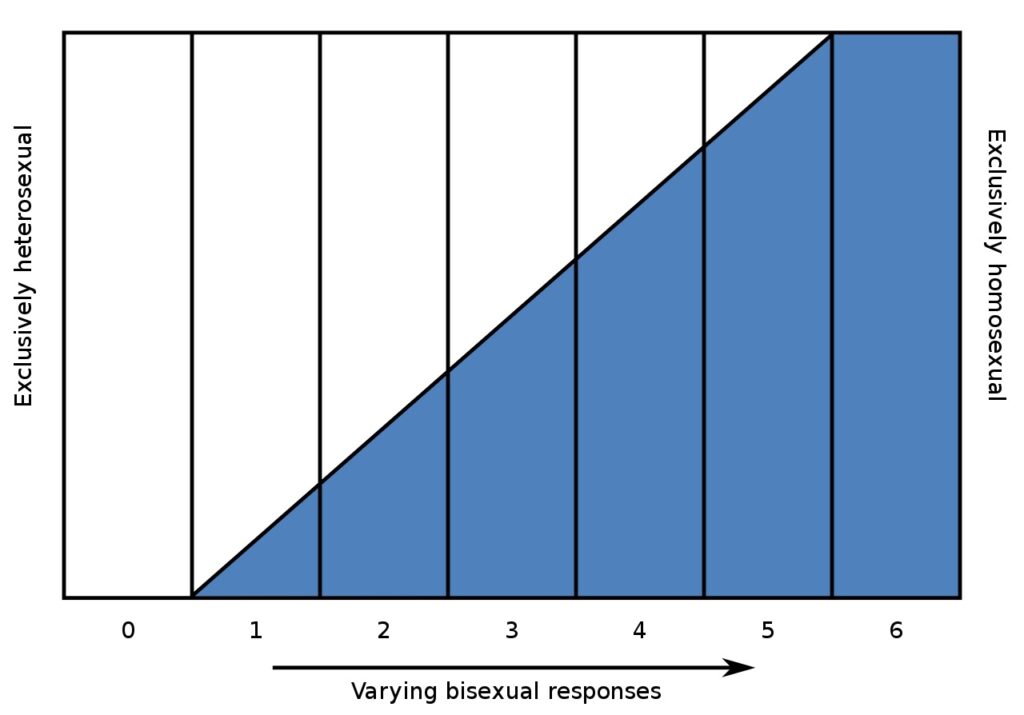
Contrary to popular belief, sexuality is not binary. Sexual orientation is not limited to the two categories of heterosexual and homosexual. Rather, there is a whole spectrum of sexuality and people may fall in between certain categories or change their minds over time. Biologist and sexologist Alfred C. Kinsey captures this idea with his seven-point heterosexual-homosexual rating scale, which is known as the Kinsey Scale.1
Table of Contents
Kinsey’s Early Life
Having influenced the “Sexual Revolution” of the 1960s, Alfred C. Kinsey is considered one of the most influential human sexuality researchers of the 20th century. Kinsey was born on June 23, 1894, in Hoboken, New Jersey.2 Growing up, Kinsey had an interest in studying biology.
However, his religious father insisted that he should focus on engineering. Despite his father’s disapproval, Kinsey chose to study biology at Bowdoin College in Maine. Kinsey enjoyed studying biology so much that he continued his studies after graduation. In 1919, Kinsey earned his doctoral degree from Harvard and joined the Indiana University faculty.2
While teaching at Indiana University, Kinsey’s research shifted from biology to sexuality. Consequently, he found himself lecturing against the rigid, sexually repressive Victorian morality of the 1800s. For instance, Kinsey taught his students that “nearly all the so-called sexual perversions fall within the range of biological normality.”2 This meant that most behaviors that are considered sexually deviant in our society are biologically normal. He wanted to replace the constricting social norms of sexuality with a newer, broader biological definition. As a result, Kinsey’s popularity at Indiana University grew and enrollment for his lectures multiplied.
Publication of the Male and Female Sexuality
With the financial support of the Rockefeller Foundation, Kinsey began to conduct in-depth interviews with male and female students about their sexual histories. Kinsey published his research in two separate publications: Sexual Behavior in the Human Male (1948) and Sexual Behavior in the Human Female (1953).2
Together, the books contained over 11,000 sexual histories and “provided a series of revelations about the prevalence of masturbation, adulterous sexual activity, and homosexuality.”2 Although the books were long and styled with dry scientific writing, both books were considered financially and critically successful.
The Kinsey Scale
While collecting research for his male and female sexuality publications, Kinsey and his colleagues revealed that, contrary to popular belief, sexuality is not black or white, but rather it is a large spectrum of sexual variations.
During the interviews, Kinsey uncovered that sexual attraction to the opposite-sex was not always consistent. Kinsey wrote, “Males do not represent two discrete populations, heterosexual and homosexual. The world is not to be divided into sheep and goats…The living world is a continuum in each and every one of its aspects.”1 In order to accommodate his research and findings, he created a chart that demonstrated the large diversities in sexuality: the Kinsey Scale.
The Kinsey Scale, also known as the heterosexual-homosexual rating scale, is a seven-point numerical chart that categorizes sexual preferences. For instance, a “zero” on the charts categorizes a person as exclusively heterosexual, and a “six” on the chart indicates a person is entirely homosexual.
The chart is mutually exclusive, which means that people can not belong to more than one category. For example, a person cannot be both a category “zero” and “one.”1

- 0- Exclusively heterosexual with no homosexual
- 1- Predominantly heterosexual, only incidentally homosexual
- 2- Predominantly heterosexual, but more than incidentally homosexual
- 3- Equally heterosexual and homosexual
- 4- Predominantly homosexual, but more than incidentally heterosexual
- 5- Predominantly homosexual, only incidentally heterosexual
- 6- Exclusively homosexual with no heterosexual

It is worthwhile to note that even within a particular sexual orientation label, there is still variation. For example, scale ratings 0 and 1 are both associated with heterosexuality, even though category 1 includes incidental homosexual acts.
To break down the categorizations:⁴
- Scale ratings 0 and 1 are considered heterosexual
- Scale ratings 2, 3, and 4 are considered bisexual
- Scale ratings 5 and 6 are considered homosexual
Kinsey discovered that most people did not fall under the two extremes: exclusively heterosexual (rating 0) or exclusively homosexual (rating 6). Although the attraction varied, most people displayed some sort of sexual fascination with both the opposite and same sex.
Contrary to popular belief, the Kinsey scale is not a test. Many websites claim to provide people with Kinsey scores. However, these results are completely fabricated. Kinsey was only able to categorize a person after extensive, detailed, and personalized interviews.
Criticisms of the Kinsey Scale and Publications
The most serious criticism of Kinsey’s publications is that his samples of 11,000 interviewees “were not representative of the general population.”3 Most of the people that Kinsey interviewed were students that attended Indiana University and the surrounding areas. Opponents argued that his sample population was skewed towards urban, college-aged students. They claimed that the urban youth were much more likely to experiment in their sexuality than the general population.
Additionally, the Kinsey Scale only measures sexual behavior and fails to include emotions.⁴ Individuals can have sexual feelings or desires and not act on them. These individuals with unstated sexual feelings would be incorrectly categorized on the Kinsey Scale.
The Klein Sexual Orientation Grid
The Klein Sexual Orientation Grid was introduced by Dr. Fritz Klein in his book, The Bisexual Option. This grid incorporated some of the criticisms of the Kinsey Scale and created a more in-depth and flexible categorization. Instead of determining sexual orientation based solely on behaviors, Klein measured sexual attraction, sexual behavior, sexual fantasies, emotional preference, social preference, heterosexual/homosexual lifestyle, and self-identification.⁵ By including additional factors to his test, Klein was able to account for sexual feelings or thoughts that had not been acted on. Additionally, Klein measured past, present, and desired behavior. This element captures the dynamic aspect of sexuality and records its change over time.
Using the seven aforementioned variables and the three different time measurements, Klein created a 21-space grid that incorporates many of the different aspects of sexuality. Each category receives a rating from 1 (heterosexual only) to 7 (homosexual only).⁵ The chart is a more holistic way of viewing sexuality and provides more variability than the original Kinsey Scale.
Concluding Remarks
While these scales and grids can be helpful in discovering one’s sexuality, they do not always cover every aspect of the sexuality spectrum. They should be used as tools for understanding and self-assessment. If you are in the process of discovering your sexuality, it is worthwhile to speak to a professional therapist if you are having trouble grappling with the many dimensions of your sexuality.
References
- ” Kinsey Sexuality Rating Scale.” Web. The Kinsey Institute, 2014.
- ” Dr. Alfred C. Kinsey.” Web. The Kinsey Institute, . 2019.
- “Timeline: Alfred Kinsey’s Life, and Sex Research and Social Policies in America.” Web. PBS, 2014.
- Clark, Terri. “Kinsey, Klein, and Everything in Between.” Web. American Society of Aging, 2020.
- “The Klein Sexual Orientation Grid.” Web. American Institution of Bisexuality, 2014.
Last Updated: 02 June 2020.
